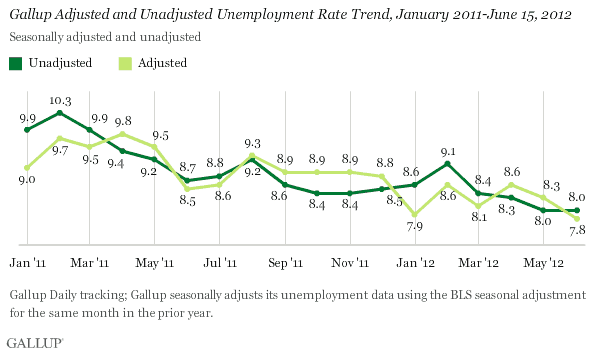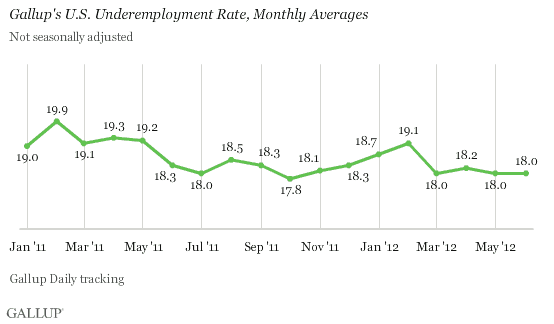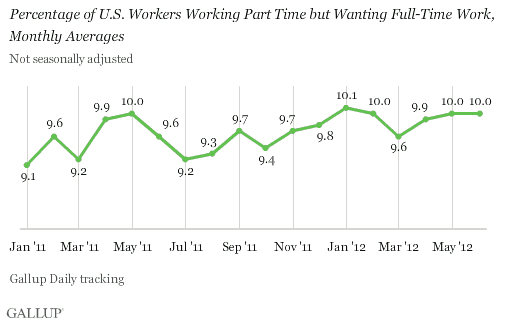WASHINGTON, D.C. -- U.S. unemployment, as measured by Gallup without seasonal adjustment, is 8.0% in mid-June, unchanged from the end of May but significantly better than the 8.7% for the month of June 2011. Gallup's seasonally adjusted number is 7.8%, an improvement from 8.3% at the end of May, and down slightly from the previous seasonally adjusted low of 7.9%, measured in January.

These results are based on Gallup Daily tracking interviews, conducted by landline and cell phone, with almost 30,000 Americans throughout the month. Gallup calculates a seasonally adjusted unemployment rate by applying the adjustment factor the government used for the same month in the previous year. The government last year adjusted the May numbers up, but adjusted the June numbers down, which accounts for the seasonally adjusted change between May and June.
Although Gallup's unadjusted unemployment rate was unchanged on June 15, the 30-day average dipped below the 8.0% mark, to 7.9% or 7.8%, on five days in early June. This marks the first time unemployment has dropped below 8.0% in the 30-day rolling averages since Gallup started collecting employment data in January 2010.
U.S. underemployment, as measured without seasonal adjustment, was stagnant at 18%. This is a modest improvement from 18.3% in the full month of June 2011. Gallup's U.S. underemployment measure combines the unemployed with those working part time but looking for full-time work. Gallup does not apply a seasonal adjustment to underemployment.

The percentage of part-timers wanting full-time work was 10%, also unchanged over the last two weeks. However, this marks an increase over the 9.6% measure from all of June a year ago, indicating that more people are searching for full-time work.

Implications
The improvement in Gallup's seasonally adjusted unemployment rate in mid-June suggests the U.S. Bureau of Labor Statistics may report a drop in the unemployment rate when it releases its June numbers on July 6. However, it is important to remember that month-over-month change in the government figures released in early July will reflect routine shifts in the government's May and June seasonal adjustments -- as well as actual underlying changes.
The year-over-year increase in part-timers not working at their capacity is troubling in light of the decline in unemployment. The unemployment decline may paint a rosier jobs picture than is warranted and would mask the persistent fact that 18% of U.S. workers are having difficulty finding the level of employment they would like. Anyone who works at least an hour per week for pay is considered "employed," by both the BLS and Gallup.
For example, if a worker spends two hours a week mowing lawns and gets paid, that person is counted as employed, even if he or she wants to work full time. So while fewer people are unemployed, many are still not working at their desired capacity, as measured by Gallup's underemployment rate. The discrepancy between the two measures may indicate employers' reluctance to offer full-time jobs. Alternatively, this number could also signal optimism among part-time workers, who sense an improving job market and have renewed their efforts to find full-time work. It will be important to monitor both unemployment and underemployment in the coming months to get the complete picture of employment in the United States.
Gallup.com reports results from these indexes in daily, weekly, and monthly averages and in Gallup.com stories. Complete trend data are always available to view and export in the following charts:
Daily: Employment, Economic Confidence, Job Creation, Consumer Spending
Weekly: Employment, Economic Confidence, Job Creation, Consumer Spending
Read more about Gallup's economic measures.
View our economic release schedule.
Survey Methods
Results are based on telephone interviews conducted as part of Gallup Daily tracking from May 16-June 15, 2012, with a random sample of 29,243 adults, aged 18 and older, living in all 50 U.S. states and the District of Columbia, selected using random-digit-dial sampling.
For results based on the total sample of national adults, one can say with 95% confidence that the maximum margin of sampling error is ±1 percentage point.
Interviews are conducted with respondents on landline telephones and cellular phones, with interviews conducted in Spanish for respondents who are primarily Spanish-speaking. Each sample includes a minimum quota of 400 cell phone respondents and 600 landline respondents per 1,000 national adults, with additional minimum quotas among landline respondents by region. Landline telephone numbers are chosen at random among listed telephone numbers. Cell phone numbers are selected using random-digit-dial methods. Landline respondents are chosen at random within each household on the basis of which member had the most recent birthday.
Samples are weighted by gender, age, race, Hispanic ethnicity, education, region, adults in the household, and phone status (cell phone only/landline only/both, cell phone mostly, and having an unlisted landline number). Demographic weighting targets are based on the March 2011 Current Population Survey figures for the aged 18 and older non-institutionalized population living in U.S. telephone households. All reported margins of sampling error include the computed design effects for weighting and sample design.
In addition to sampling error, question wording and practical difficulties in conducting surveys can introduce error or bias into the findings of public opinion polls.
For more details on Gallup's polling methodology, visit www.gallup.com.
